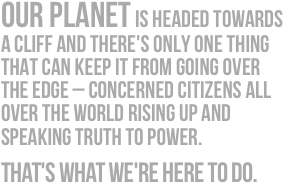by Trudi Zundel
It’s a fairly grotesque analogy: the Nagoya protocol as a newborn infant, finally emerging after years of arduous labour, ready to face the world but also helpless, in need of nurture and care. One would (or at least I did) expect the UN to be too reserved a forum for such visuals, yet Janet Lowe, ICNP Co-Chair from New Zealand, has analogised the Nagoya Protocol as such. This was not just a one-off metaphor, though; it has popped up several times in the discourse so far. In response to protests by Egypt about the text, the Co-Chair said that “sometimes babies cry not because something is wrong but because they want attention.” The Nagoya Protocol isn’t just any newborn, it’s a colicky one at that. If one was to extend the infant analogy of the Nagoya Protocol a bit farther, poor baby Nagoya’s story gets pretty dark.
Its parents had a difficult time conceiving. They tried for years and years but couldn’t seem to agree on the process. Finally, on the final night of the COP in Nagoya, a baby simply needed to be made. There was no time for the natural process, but thankfully the Co-Chairs came to the rescue and said “Here! Adopt my baby!” And so, the Nagoya Protocol was ‘born,’ or rather ‘adopted’ (… kind of a COP-out). There was no going back. It was a living, fixed organism, in the charge of the Secretariat and the States.
I know they say that parents love adopted babies as much as their own, but in this instance that may not be the case. The baby is really difficult! It cries for attention, according to Lowe, of its own accord. States appear to be the reluctant parents of this bawling infant. And while all babies need to be nurtured into good health, its parents may have unwittingly adopted a terminally ill, or significantly disabled, child. That’s not politically correct to say, and makes me very uncomfortable. I would never refer to an actual baby in that manner. And I guess it’s here that the metaphor of baby Nagoya Protocol falls apart.
The Nagoya Protocol is not a baby. It is a document. We don’t need to be politically correct in referring to a document –it doesn’t have rights! It’s inanimate! While metaphors such as these are useful, they are also dangerous in their reductions. Personifying and infantilizing the Nagoya Protocol creates an image that is hard to escape from, one which places the Parties in a passive role, separate from the process of its creation and left to make the best of the outcome. Escaping from the baby metaphor could change the game a bit.
The process of developing a foetus is passive gestation, and parents have limited say in whatever baby comes out. The Nagoya Protocol’s imperfections are not the result of genetic probabilities, though, but of foreseeable and negotiable issues within a complex global political system. It is not newborn! It is one of many textual manifestations of years and years of genetic resource trade, politics, and exploitation. While it’s a fixed document, of course it should be criticized. Of course we should reflect on the skewed process that resulted in its creation, take responsibility for it.
The flawed process has been acknowledged, and I understand that the Co-Chair’s plea to keep moving forward and nurturing the Protocol was aimed at avoiding a re-negotiation the content or wording of the Nagoya Protocol. However, the analogy continues throughout projections for the future of the protocol: States and the Chair have mentioned that “the baby needs to crawl before it can walk,” “it may stumble but will pick itself up and carry on,” and numerous other references. This personification is problematic because it absolves Parties, to a certain extent, from their responsibility in shaping the Protocol as it develops. While they’re responsible for nurturing and encouraging it, it will carry on and become independent.
This is a very dangerous idea. For the Protocol’s mechanisms to a) begin to meet the needs of its Member States, and b) to continue to meet their needs, they require constant attention and commitment from all Stakeholders. A Protocol left to itself isn’t actually independent; it is only run and influenced more subtly. As we’ve seen here in Montreal, the Secretariat is far from neutral, and States need to pay consistent heed to keep the Bureau and Secretariat in check. The document doesn’t need to be nurtured, it needs to be whipped into shape. You can’t whip a baby.
It is difficult to implement a Protocol that Parties don’t agree with. I think that States, and the Chairs that facilitate the meeting, should try to ensure that any protocol that is “born” meets the needs of the Parties creating it, and that all issues are fully negotiated. Adopting a baby just for the sake of “having a baby” is a silly idea–especially when the baby isn’t actually a baby, but is instead a flawed Protocol that will have significant effects in the real world. A protocol has the potential for positive or very, very negative results, and the outcome depends less on what happens after it’s “born” and more on the active, dynamic process that creates it.


